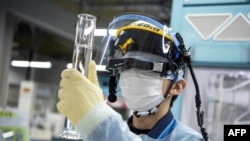On May 10, China called Japan’s plan to release more than 1 million tons of treated radioactive water from the destroyed Fukushima nuclear plant into the Pacific Ocean “extremely irresponsible.”
“Many people may wonder why Japan won’t discharge the nuclear-contaminated water, which it claims to be safe and harmless, into Japan’s inland rivers or use it for agricultural and industrial purposes and instead insists on dumping it into the ocean? It is extremely irresponsible of Japan to selfishly put the world at risk,” Foreign Ministry spokesperson Wang Wenbin said at a daily news conference.
That is false.
The wastewater goes through a chain of advanced filters before being released into the Pacific, and scientists say its impact on the oceanic environment will be negligible.
Japan’s government considered multiple plans for safely disposing of the contaminated water before approving its release into the Pacific Ocean after it is thoroughly treated.
The issue arose a decade ago, when a magnitude 9.0 earthquake caused three reactor meltdowns at Japan’s Fukushima plant.
Japanese authorities were forced to use a large quantity of water to cool down the damaged nuclear reactors and prevent the debris from overheating and causing further damage.
That water was subsequently stored in huge tanks at the plant. Currently, 1.3 million tons of radioactive water, enough to fill about 500 Olympic-size swimming pools, is being stored in 1000 tanks.
But space is running out.
The Japanese government examined five options over a five-year period, including evaporating the radioactive water into the atmosphere. Finally, in 2020 Tokyo said the cheapest and fastest option would be to release the water into the sea after diluting the contaminated water thoroughly. The government formally authorized that plan in April 2021, and in January 2023 announced that the release could begin this spring or summer.
Tokyo Electric Power Company (TEPCO), which oversees the decommission process, will run the contaminated water through a complex chain of filters called the “Advanced Liquid Processing System” (ALPS).
Third parties, including the International Atomic Energy Agency (IAEA), will monitor the process.
According to the IAEA, the ALPS treatment captures 62 kinds of radionuclides, but not tritium, a radioactive isotope that’s extremely difficult to remove from the water.
Tritium has a half-life of 12.3 years, meaning 100 years have to pass before the radioactivity becomes negligible. According to the IAEA, tritium emits weak beta-particles, and “may present a radiation hazard if inhaled or ingested but is only harmful to humans in very large doses.”
Scientists also noted that radiation is naturally common in the atmosphere. In addition, around 8.4 kilograms of tritium are already in the Pacific Ocean. By comparison, the Fukushima wastewater contains a total of three grams of tritium.
Japan is not planning to release the treated radioactive water all at once. The process will take up to 30 years, and only a tiny amount, 0.06 of a gram of tritium, is scheduled to be released each year.
“Compared with the radioactivity already present in the Pacific, the planned annual release is a literal drop in the ocean,” three Australian scientists wrote in a joint report.
The water will be treated and, if necessary, treated again until the concentration of radionuclides other than tritium is below government limits, said Hikaru Kuroda, a TEPCO official overseeing the decontamination and decommissioning of Fukushima Daiichi.
In February 2023, the South Korean government published a study which indicated that the release of Fukushima wastewater would have a negligible effect on South Korean waters.
On May 13, Japan agreed to allow South Korean experts to visit the Fukushima nuclear plant before it begins releasing the treated radioactive water.
The Pacific island country of Micronesia, once the fiercest critics of Japan’s decision, said earlier this year that, after thorough consultations with Tokyo, it’s no longer concerned about the plan to release the Fukushima wastewater.
Scientists have also endorsed the Japanese government’s plan for its release.
“It is essentially impossible to separate the tritium from the water. Disposal, via release into the nearby ocean is the only viable option for the volume of material. Once diluted in the ocean the tritium will not present a hazard to marine life,” said Brendan Kennedy, a chemist at the University of Sydney.





